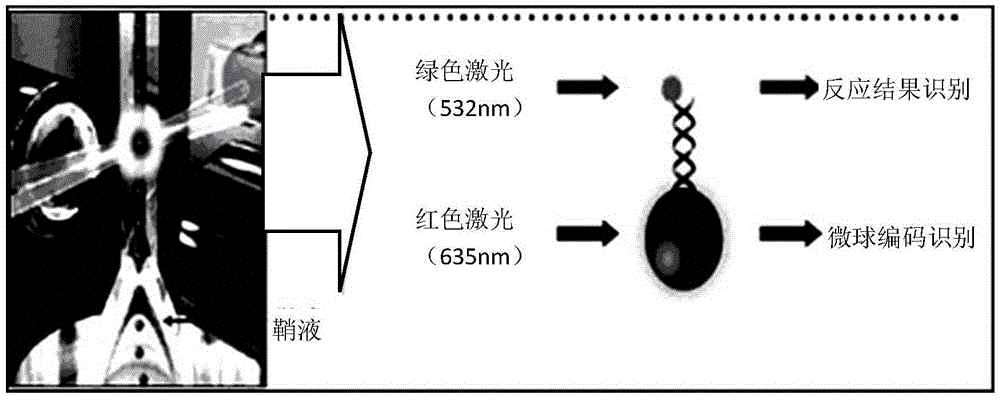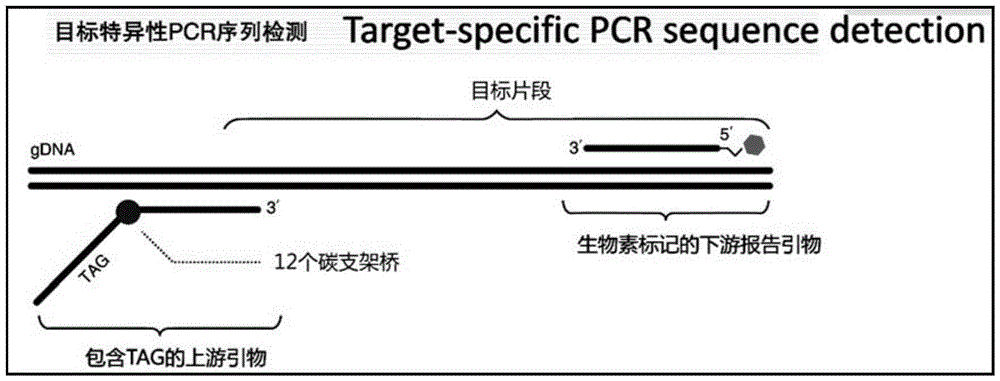Liquid-phase chip kit for screening seven virulence genes of streptococcus suis
A liquid-phase chip, virulence gene technology, applied in microorganism-based methods, microbial determination/inspection, microorganisms, etc., can solve problems such as heavy workload, pollution, and low sensitivity, and achieve improved specificity and sensitivity. The effect of high degree and development of application prospects
- Summary
- Abstract
- Description
- Claims
- Application Information
AI Technical Summary
Problems solved by technology
Method used
Image
Examples
Embodiment 1
[0027] Embodiment 1 kit design principle
[0028] The present invention first designed specific primers for seven virulence factors including gdh, orf2, mrp, gapdh, fbps, epf, and sly, designed them using DNAstar, and sent them to Shanghai Sunny for synthesis.
[0029] The specific primer sequence is shown in SEQ ID NO: 1-14, and then sent to Shanghai Sunny Biotechnology Co., Ltd. for synthesis. After establishing and optimizing the single-plex PCR detection system for each of the seven primers (gdh, orf2, mrp, gapdh, fbps, epf, sly), they were combined and divided into two groups according to the principle that the annealing temperature is relatively close to the band size and the distance between them is relatively obvious. Groups are group 1 (fbps, gdh, orf2, mrp), group 2 (sly, gapdh, epf), see Figure 5 with Image 6 .
[0030] On the basis of multiple PCR in the early stage, a TAG sequence is added to the 5' end of the specific upstream primer, and 12 carbon bridges a...
Embodiment 2
[0034] Embodiment 2 kit composition
[0035] Multiplex PCR reagent: PCR system 24.5μL
[0036] Combination 1 (contains multiplex PCRMix12.5μL, fbps, gdh, orf2, mrp primers 1μL each, ddH 2 08 μL), combination 2 (including multiplex PCR Mix 12.5 μL, sly, gapdh, epf primers 1 μL each, ddH2O 9 μL).
[0037] Liquid phase chip reagent: 90 μL of reaction system, including 1 μL of each coded reaction microsphere, 1×Tm to 20 μL, 70 μL of SAPE diluent (69.3 μL of 1×Tm and 0.7 μL of SAPE).
Embodiment 3
[0038] Example 3 Kit usage method
[0039] 1. Multiplex PCR
[0040] The reaction system is 25 μL, 24.5 μL multiplex PCR reagent (combination 1, 2) and 0.5 μL nucleic acid to be tested (10 ng / μL).
[0041] Operation steps: After diluting the nucleic acid of the sample to be tested according to the above requirements, add it to the two combined multiplex PCRs in the kit.
[0042] Reaction conditions: 95°C for 5min; 95°C for 30s; 56°C for 30s; 72°C for 1min; 40 cycles, 72°C for 10min.
[0043]2. Hybridization
[0044] 1. Use 2500 microspheres for each coded microsphere to participate in the reaction (ie 1 μL), and make up to 20 μL with 1×Tm;
[0045] 2. Add 2 μL of the above-mentioned PCR amplified product and adjust to a final volume of 25 μL with ddH2O;
[0046] 3. Dilute SAPE to 8 μg / ml with 1×Tm hybridization buffer, add 70 μL to each reaction well, and mix gently;
[0047] 4. Put it into the PCR instrument and hybridize for 35 minutes at 40°C (see Figure 4 ).
[004...
PUM
| Property | Measurement | Unit |
|---|---|---|
| Sensitivity | aaaaa | aaaaa |
Abstract
Description
Claims
Application Information
 Login to View More
Login to View More - R&D
- Intellectual Property
- Life Sciences
- Materials
- Tech Scout
- Unparalleled Data Quality
- Higher Quality Content
- 60% Fewer Hallucinations
Browse by: Latest US Patents, China's latest patents, Technical Efficacy Thesaurus, Application Domain, Technology Topic, Popular Technical Reports.
© 2025 PatSnap. All rights reserved.Legal|Privacy policy|Modern Slavery Act Transparency Statement|Sitemap|About US| Contact US: help@patsnap.com



